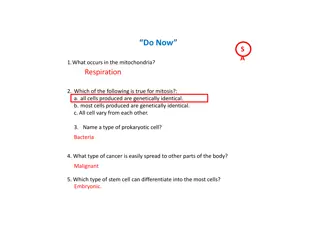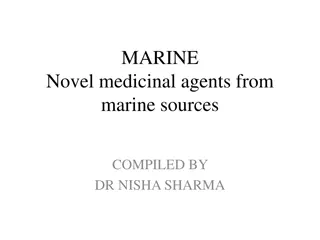Bacterial Biochemical Identification Tests in Microbiology
Understand the significance of biochemical tests like the Triple Sugar Iron Agar Test (TSI) and the IMViC Test for identifying enteric bacteria. Learn about indole production, methyl red test, and other methods used in bacteriology.
5 views • 17 slides
Culture Media
Culture media play a crucial role in isolating bacteria from clinical specimens. Water, electrolytes, peptone, agar, meat extract, yeast extract, and blood/serum are essential constituents used in culture media. These components provide nutrients, solidifying agents, and growth factors necessary for
1 views • 26 slides
Safety Measures for Growing Microorganisms in the Laboratory
In the laboratory, it is crucial to use aseptic techniques when dealing with microorganisms to prevent contamination and ensure safe growth. Understanding the importance of agar plates, Petri dishes, and incubators in creating optimal conditions for microbial growth is essential. By following proper
0 views • 25 slides
Bacterial Culture Transfer Techniques and Growth Indicators
Bacterial cultures can be transferred using aseptic techniques to ensure purity. Growth indicators such as turbidity in liquid media and colonies on agar plates signify microbial growth. Proper sterilization and handling of instruments are crucial in the process. Techniques like streaking on agar pl
1 views • 4 slides
Understanding Anaerobic Infections: A Case Study in Clinical Microbiology
In this case study, two patients present with fever, neck pain, and previous misdiagnoses of viral pharyngitis. Blood cultures reveal anaerobic growth, with Gram stain showing pleomorphic Gram-negative rods. Anaerobic cultures require specialized conditions for growth, such as anaerobic glove box in
1 views • 14 slides
Understanding Antibiotic Susceptibility Testing Methods
Antibiotic susceptibility testing is crucial for determining effective antibiotics against bacterial infections. Common methods include Kirby-Bauer and agar disk diffusion, evaluating zones of inhibition to categorize susceptibility. Techniques involve seeding agar plates, placing antibiotic disks,
2 views • 17 slides
Klebsiella Species: Characteristics and Pathogenicity
Klebsiella species, such as K. pneumoniae and K. oxytoca, are gram-negative bacilli commonly found in the microbiota of the intestines, nasopharynx, and feces. They exhibit distinct characteristics like pink mucoid colonies on MacConkey's agar and are known to cause both community-acquired and hospi
0 views • 24 slides
Understanding Biochemical Tests for Bacterial Identification
Explore the importance of biochemical tests like Triple Sugar Iron Agar and IMViC in identifying enteric bacteria. Learn about indole production and the Methyl Red test, essential in distinguishing bacterial species based on their metabolic activities. Discover how these tests aid in diagnosing food
2 views • 17 slides
Understanding Proteus Bacteria: Historical Significance, Pathogenesis, and Laboratory Diagnosis
Proteus species, named after the Greek god Proteus, exhibit pleomorphism. Their historical importance stems from the unique characteristics of H and O antigens, with flagellated strains resembling a thin film on agar. Pathogenically, Proteus mirabilis and P. vulgaris are opportunistic pathogens caus
0 views • 12 slides
Marine Novel Medicinal Agents from Marine Sources Compiled by Dr. Nisha Sharma
Oceans, covering more than 70% of the Earth's surface, harbor a plethora of invertebrates and algal species, providing a rich source of medicinal compounds. Marine organisms have yielded commonly used drugs like shark and cod-liver oils, sodium alginate, agar-agar, and chitin. Various classification
1 views • 9 slides
Understanding Anaerobic Bacterial Growth and Culturing Methods
Anaerobic bacteria have specific sensitivities to oxygen, with categories such as aerobic, obligate anaerobes, facultative anaerobes, aerotolerant anaerobes, microaerophiles, and capnophilic bacteria. Methods like Anaerobic Jar and GasPak system are used for cultivating anaerobic bacteria, ensuring
0 views • 7 slides
Methods for Determination of Microbial Growth
Quantitative determination of microbial growth is crucial for various purposes, with two commonly used methods being the standard plate count and spectrophotometric measurement. The standard plate count method estimates living microbial cell density, while spectrophotometric measurement relies on tu
2 views • 6 slides
Understanding Triple Sugar Iron Agar (TSI Agar) Test
Triple Sugar Iron Agar (TSI Agar) is a differential media used for identifying gram-negative enteric bacilli based on carbohydrate fermentation and hydrogen sulfide production. It helps detect carbohydrate fermentation, gas production, acidification, and H2S formation, providing valuable information
1 views • 28 slides
Understanding Antibiotic Susceptibility Testing
Antibiotic susceptibility testing is crucial in determining the effectiveness of antibiotics against specific bacteria. The Kirby-Bauer method, a standardized paper disk agar diffusion method, is commonly used for this purpose. By observing zones of inhibition around antibiotic disks on agar plates,
1 views • 21 slides
Understanding the Triple Sugar Iron Test in Biochemical Analysis
The Triple Sugar Iron Test (TSI) is a crucial biochemical test used to differentiate gram-negative enteric bacilli based on their carbohydrate fermentation and hydrogen sulfide production. By examining color changes, gas production, and precipitate formation, microbiologists can interpret TSI result
2 views • 31 slides
Understanding Proteus Species: Morphology, Cultural Characteristics, and Antigenic Structure
Proteus species, specifically P. mirabilis and P. vulgaris, are important opportunistic pathogens in human infections. They exhibit unique characteristics such as swarming growth on agar, gram-negative coccobacilli morphology, and distinctive antigenic structures with O and H antigens. The swarming
2 views • 25 slides
Understanding Culture Media for Microorganisms
Culture media play a vital role in the growth and study of microorganisms. This content covers the primary ingredients required by all living organisms, types of culture media based on physical state, and specific media for bacteria and fungi. It explains the components and purposes of different typ
0 views • 24 slides
Understanding Bacterial Colony Morphology for Microbiology Analysis
Bacterial colonial morphology plays a crucial role in identifying bacteria and fungi. This exercise focuses on recognizing the cultural characteristics of bacteria on agar plates through colony morphology. Each colony represents a genetically similar group of microorganisms derived from a single cel
1 views • 6 slides
Understanding Antibiotic Susceptibility Testing in Medical Microbiology Lab
Antibiotics are chemical substances produced by microorganisms to inhibit or kill other microorganisms. In the lab, antibiotics susceptibility testing is conducted using the Disc Diffusion method (Kirby-Bauer method) on agar plates. The sensitivity of bacteria to antibiotics is determined by measuri
0 views • 11 slides
Understanding Triple Sugar Iron Agar (TSI Agar) Test in Microbiology
Gain insights into the Triple Sugar Iron Agar (TSI Agar) test used for differentiating gram-negative enteric bacilli based on carbohydrate fermentation and hydrogen sulfide production. Learn about detecting carbohydrate fermentation, interpreting results, and performing the test accurately with deta
0 views • 28 slides
Understanding Selective and Differential Media in Clinical Microbiology
Mannitol Salt Agar, MacConkey's Agar, Eosin Methylene Blue Agar, and Salmonella Shigella Agar are crucial tools in clinical microbiology for isolating and identifying specific bacteria. These selective and differential media help differentiate between different strains based on their ability to ferm
0 views • 13 slides
Pure Culture Preparation by Streak Plate Method
Bacteria often exist in mixed populations, making it essential to isolate them for studying their characteristics. The streak plate method, involving streaking nutrient agar and incubating, helps in obtaining pure cultures of individual species. This method facilitates the observation of isolated co
0 views • 5 slides
Main Characteristics of Rhodophyta: The Red Algae Division
Rhodophyta, or red algae, are mostly marine algae with distinct photosynthetic pigments giving them a red color. Their main characteristics include the presence of phycoerythrin pigment, floridean starch as food reserve, thalloid plant body structure, oogamous sexual reproduction, and cell walls con
0 views • 27 slides
Microbial Isolation Techniques and Methods
This content provides a detailed guide on the isolation of microbes from various environments using techniques such as sample introduction, inoculation, incubation, inspection, and identification. It includes information on the use of an incubator, materials, and methods required for microbial isola
0 views • 13 slides
Phytochemical Screening and Antimicrobial Assessment of Mimosa pudica
This study explores the antimicrobial potential of Mimosa pudica extracts through phytochemical screening. Researchers investigated the leaves' antimicrobial characteristics and screened for phytochemical compositions to understand their effects on various microorganisms. The methodology involved sa
0 views • 18 slides
Exploring the Fascinating World of Algae: Characteristics, Types, and Applications
Delve into the intriguing realm of algae, from their general characteristics to the various types such as Diatoms, Green Algae, Blue-Green Algae, Yellow-Green Algae, and Red Algae. Algae range from microscopic to seaweed, serving as autotrophic organisms with reproductive structures like gametangia.
0 views • 16 slides
Mushroom Culture Sterilization and Slants Preparation Methods
Learn about the sterilization methods for glassware, agar medium, and culture medium in mushroom culture. Understand the preparation of agar slants and culture slants to maintain a sterile environment for successful cultivation. Follow detailed procedures for sterilization at different levels in the
0 views • 17 slides
Antimicrobial Activity of Moringa Oleifera, Aloe Vera on Multidrug-Resistant Bacteria
Antibiotic resistance poses a significant global health threat, leading to increased mortality and morbidity. This study investigates the antimicrobial properties of Moringa Oleifera, Aloe Vera, and Warbugia Ugandensis on multidrug-resistant Escherichia coli, Pseudomonas aeruginosa, and Staphylococc
0 views • 17 slides



























